|
STOL
Series
PHOTO LIBRARIES:
NEW
Library #125
NEW
Library #124
Library #123
Library #122
Library #121
Library #120
Library
#119
Library
#118
Library
#117
Library
#116
Library
#115
Library
#114
Library
#113
Library
#112
Library
#111
Library
#110
Library
#109
Library
#108
Library
#107
Library
#106
Library
#105
Library
#104
Library
#103
Library
#102
Library
#101
Library
#100
Library
#99
Library
#98
Library
#97
Library
#96
Library
#95
Library
#94
Library
#93
Library
#92
Library
#91
Library
#90
Library
#89
Library
#88
Library
#87
Library
#86
Library
#85
Library
#84
Library
#83
Library
#82
Library
#81
Library
#80
Library
#79
Library
#78
Library
#77
Library
#76
Library
#75
Library
#74
Library
#73
Library
#72
Library
#71
Library
#70
Library
#69
Library
#68
Library
#67
Library
#66
Library
#65
Library
#64
Library
#63
Library
#62
Library
#61
Library
#60
Library
#59
Library
#58
Library
#57
Library
#56
Library
#55
Library
#54
Library
#53
Library
#52
Library
#51
Library
#50
Library
#49
Library
#48
Library
#47
Library
#46
Library
#45
Library
#44
Library
#43
Library
#42
Library
#41
Library
#40
Library
#39
Library
#38
Library
#37
Library
#36
Library
#35
Library
#34
Library
#33
Library
#32
Library
#31
Library
#30
Library
#29
Library
#28
Library
#27
Library
#26
Library
#25
Library
#24
Library
#23
Library
#22
Library
#21
Library
#20
Library
#19
ENGINE INSTALLATIONS:
Library #18
Library
#17
Library
#16
Library
#15
Library
#14
Library
#13
Library
#12
MOUNTAIN FLYING:
Library
#11
INSTRUMENT PANELS:
Library
#10
Library
#9
Library
#8
Sub-Sahara Desert
Library
#7
Library
#6
Library
#5
Library
#4
EXTREME FLIGHT:
Mountain
Flying
Library
#3
Library
#1
First
Photo
Page
STOL Copies
Assembly
& Construction Photos
Videos
Zenith.Aero
Follow us for updates:
|
|
The popularity of
the STOL CH 701 aircraft and other Heintz designs around the world has created many imitations and copies. These
copies are often modified versions of the original STOL CH 701, and are not authorized by
designer Chris Heintz.
While imitation may be a form of flattery, Heintz cautions that these planes may not be
built to original specifications, and that modifications may not, and often appear not, to
be properly engineered (usually you decide to copy when you don't have the engineering
ability to create your own design).
Zenith Aircraft Company cannot support aircraft that do not have a valid serial
number, nor can it support aircraft built from parts manufactured by a third
party, and cautions buyers that just because it may "look" like a
STOL CH 701 it may not be built from parts manufactured to the same
standards, or may be built from parts made from inferior raw materials, and
that modifications are not approved by the designer.
The following photos were all found on the
internet. Let us know if you come across a design that
has an uncanny similarity to a Chris Heintz design...
International
Customers: Please verify that a representative
or dealer is authorized by Zenair:
Zenith Aircraft International Sales | Zenair
Website
 |
Aero Bravo of Brazil builds and markets the 'Bravo' in South
America, a so-called "improved" version of the STOL CH 701, with a modified cabin
and modified tail sections. |
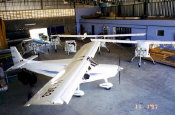 |
Manufacturing the factory-finished "Bravo" in
Brazil |
 |
This Polish STOL claims
in bold print to be a "Zenair CH-701" despite obvious design
changes to its landing gear. |
 |
Another Polish 701 |
 |
Another Polish 701
called TT 2000 |
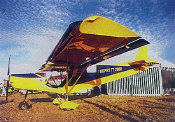 
|
Sold factory-assembled as a "Trophy 2000" by a
French company called Air Domi, this is a Polish-made version of the STOL CH 701. Other
than the landing gear, this one looks pretty original...
French magazine 'Vol Moteur' reviewed this aircraft (2/99
cover story), stating: "A true copy of the celebrated STOL CH 701,
this airplane has a very attractive price compared to the original..."
Evidently, Air Domi and the French magazine see no ethical
(or other) problems by admittedly marketing and producing a copy of a design. http://www.zut.wroclaw.pl |
 
|
 |
Marketed as a "Yuma," this plane uses
the STOL CH 701 wing. From the photo, it's hard to see the many other similarities.
|
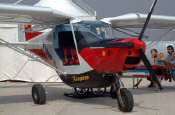 |
 |
It appears that ICP of Italy
manufactures and markets the whole line of (modified) Heintz designs. The main CH701 modifications include a raised cabin (the wing
root does not taper at the cabin) and the tail sections have been changed.
The modified STOL CH 701 is marketed as the 'Savannah'
or MXP-740 in
Europe, and is available both in kit form or factory-built.
|
 |
 |
 |
Copies of Zenair Amphibious floats are even available from
ICP... |
 |
ICP's Savannah MXP 740, also called the Bingo.
The copies are marketed by
Skykits Corporation in North America as
"painstakingly engineered in Italy," although they admit
that the Savannah is "comparable in looks and components" to
the STOL CH 701.
|
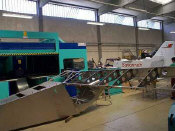 |
 |
ZODIAC CH 601 variant sold as the "Amigo" -
modified canopy and tail sections...
Italian flight report with photos |
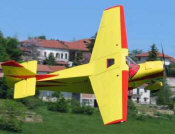 |
This is a hybrid /
mutated aircraft from Italy with STOL
CH 701 fuselage and Zodiac CH 601
HDS wings... |
 |
The Italian company not only produces copies of
the STOL CH 701, but also modified versions of the ZODIAC CH 601 HD and ZODIAC CH 601 HDS.
Their website (www.icp.it) boasts that they've delivered 157 aircraft. Super Amigo (or is it a modified Super ZODIAC CH 601 HDS?) with a
turbo 914.
The company even has international dealers...
This is the S. American dealer: http://www.mxp-aerotec.com |
 |
 |
 |
This
one was sent to us:
"The [Australian] Hornet STOL looks quite different compared to the 701
at a first glance but when I compare details it’s definitely based on
the 701. The fuselage has a different shape but the construction method
is nearly identical. Isn't it illegal to copy and use your wing?" |
 |
This is a new one, called the G1 from D.K.L. AirLight
of Luxembourg. |
 |
|
 |
|
 |
This is a Zodiac
manufactured in Poland and marketed as Zodiac CH 601 HD, sold with a
2-cylinder motorcycle engine. |
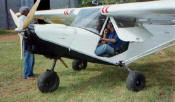 |
This Italian-made copy in India quickly offered
the new STOL CH701 features such as the top-hinged doors and new
spring gear to try to win a bid on training aircraft [details]. |
 |
A polish-built 701 copy. |
 |
A South American-built "copy of a
copy" STOL CH 701 commercially operated in Key Biscayne, Florida
(without any noticeable registration). |
 |
A Portuguese "Land
Africa" |
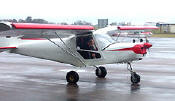 |
This one is called a
G1 |
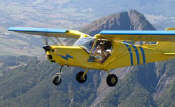 |
|
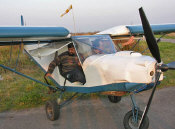 |
We're not sure what
happened to the cowl and landing gear of this 701... |
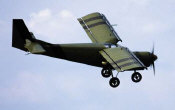 |
A detailed Russian
website that sells a "Griffen 100" plane that looks like an
exact copy of the STOL CH 701. Website has some good detailed
construction photos that unmistakably identify the design (using many
photos and illustrations from Zenith's own website!)... yet we've
found no reference to the original in the Russian text... |
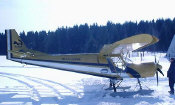 |
A near-exact copy of the
STOL CH 701 on skis, called the Griffen-100M, by Griffen Aero in Russia |
 |
Italian-made Savannah copy in Greece |
 |
|
 |
The airplane behind the
modified gear and cowl is unmistakably a STOL CH 701. |
 |
Polish Trophy 2000 |
 |
This copy is probably our
favorite ;) |
| www.ulm.it, an Italian website, has a nice section on STOL aircraft, where it
freely translates some of designer Chris Heintz' design articles
and shows photos of STOL CH 701 copies, though it states that each of
these STOL aircraft possesses its own "characteristics and
improvements..." |
Note: Copies of the original design may not
be eligible for registration as "amateur-built" or other
category aircraft. Just because they look like a STOL CH 701 does
not mean that they are.
 In
the April 2007 issue of Recreational
Flyer, the magazine of the Recreational Aircraft Assoc. of Canada,
editor Gary Wolf points out that: "Heintz is nearly alone in selling
construction plans these days, while most manufacturers concentrate on
selling kits and completed aircraft. The photocopier is the worst
enemy of every designer, and Heintz's 601 plans have been copied and
"improved" by manufacturers around the globe. Have a look
at many of the recent bumper crop of Eastern European light sport aircraft
and you will see how many have their roots in the Zodiac. Some look
very tempting, but the question must be asked where a buyer might find
parts and support five years hence. A [Zenith] Zodiac owner gets full
construction plans and a mature manufacturing company as his backup" In
the April 2007 issue of Recreational
Flyer, the magazine of the Recreational Aircraft Assoc. of Canada,
editor Gary Wolf points out that: "Heintz is nearly alone in selling
construction plans these days, while most manufacturers concentrate on
selling kits and completed aircraft. The photocopier is the worst
enemy of every designer, and Heintz's 601 plans have been copied and
"improved" by manufacturers around the globe. Have a look
at many of the recent bumper crop of Eastern European light sport aircraft
and you will see how many have their roots in the Zodiac. Some look
very tempting, but the question must be asked where a buyer might find
parts and support five years hence. A [Zenith] Zodiac owner gets full
construction plans and a mature manufacturing company as his backup"
Following is the translation of an editorial from the French
magazine EXPERIMENTAL/FOX ECHOS, May/June 2000 issue. It addresses the issue of R&D* we are experiencing
more and more.
NON-CONFORMING COPIES
By Gabriel Gavard
"Chris Heintz and sons, designers and manufacturers of
the Zodiac CH 601 and STOL CH701 series of aircraft (built from plans only, from partial
or from complete kits by homebuilders), are getting less tolerant of supposedly
"improved" pirated copies of their designs. Zenith Aircraft’s internet
homepage recently added a new link identifying rebel copies of their aircrafts originating
from Brazil, Poland and Italy. The company has been sending updates and cautionary notices
to the aviation press on a regular basis regarding these "new" machines, clearly
derived from the CH 701 or CH 601, clearly unauthorized.
"The principle cause spurring the spread of these copies
on the new light-plane market is not just the undeniable success of these two designs
– now commonly registered as ultralights in many countries. A prime contributing
factor has been the availability of complete blue-prints and assembly manuals for all
components aircraft in question from Zenith Aircraft. This intentional move by Chris
Heintz has allowed hundreds of aviation enthusiasts around the world to build and fly
their own aircraft, on a budget.
"Making these construction plans available, while not
profitable, was a generous move by Heintz in "the spirit of homebuilding". It is
also having dire commercial repercussions: The designer’s gesture has now been
dishonored and misused by a number of unscrupulous manufacturers who, by their very
actions, attest to their own inability to conceive and engineer their original aircraft.
Naturally, each of these nevertheless had the expertise to then "improve" on the
original design.
"The motivation for the modifications has been varied:
Changes to avoid "copyright" infringements; advanced or complete assemblies to
meet market demands (ready-to-fly, custom modifications, etc.); and "improved"
performances, often sadly based on strokes of ingenious intuition by novice builders not
yet fully aware that every airplane is a sum of compromises…
"Chris Heintz engineers his airplanes to well-known
stringent standards. Every component and flight characteristic is conceived to work in
harmony with the whole from the outset. The wings, fuselage and tail; the controls, the
cabin and the rest form that whole which can be appreciated in its entirety. Modify just
one, let alone several, of these elements without reviewing the whole and clearly, the
machine as a unit will have been tainted…"
* R & D: Research and
Development, but also sometimes known as ‘Rip-off and Duplicate’.
The January 2000 issue of EAA Experimenter says:
"From Italy's ICP comes two aircraft aimed at different markets. A successful company
in the automotive field, an interest in flying lead the company into microlight sales and
from there to manufacturing. Though they have no American representation at present, ICP
expressed interest in acquiring US dealers. The Savannah is an evolved version of Zenair's
popular utilitarian CH-701, which ICP once represented. ICP pilot Franco Paolini said so
many improvements have been made that the two can hardly be compared anymore. Perhaps, but
the basic shape will cause most North Americans to note the resemblance. In my experience
flying the Savannah, I was impressed with its solid feeling in the air and its good
performance and handling qualities, especially at the crawling speeds it can sustain. The
Amigo is completely different though Zenair followers may note that it imitates the CH-601
model from the Canadian designer. Unlike Savannah, the Amigo's stylish form appears and
operates more like a general aviation light plane. While I found handling to be just as
pleasant as the Savannah, the Amigo was quite a bit speedier.."
In a letter to Ultraflight
magazine, Sebastien Heintz, president of Zenith Aircraft Company wrote:
I just recently read Guy Gratton's "Biggles"
article (Ultraflight, June 2002), which chronicles the approval process
for ICP's MXP740 Savannah in the UK. The writer diplomatically states
that the Savannah is a "derivative" of our STOL CH 701 design,
but then proceeds to contact designer Chris Heintz to obtain help with
the approval of the Savannah (!).
ICP's Savannah is nothing more than a modified copy of
our popular STOL CH 701 aircraft. In fact, ICP of Italy (www.icp.it) was
a one-time distributor for the STOL CH 701 in the eighties (and also
markets an unmistakable copy of our ZODIAC
CH 601 design called the Amigo) and a closer examination of the
similarities of the design and the construction techniques shows the
Savannah to be more than a "derivative" of the STOL CH 701 -
copying the design and simple construction
techniques that designer Chris Heintz has painstakingly developed over
the past 30 years.
As the article points out, the Savannah has been on the
market for years without ever having undergone spin testing: Companies
that copy an existing design typically do so because they lack
engineering skills, and to profit from an original product's hard-won
reputation. Modifications are marketed as "improvements" over
the original design, but often these modifications are not properly
engineered and tested, as the above
demonstrates.
With form following function, the STOL CH 701 was not
designed to be just another pretty light aircraft, but was engineered to
offer outstanding short take-off and landing performance, all-metal
durability, and simplicity and ease of construction. The design features
fixed leading-edge wing slats for high lift, full-span flaperons (both
ailerons and flaps), an all-flying rudder, and simple,
yet durable, all-metal construction. Introduced in 1986, the STOL CH 701
design has been a success since the beginning because it met its design
goals, and continues to be very popular aircraft kit today as it meets
the needs of sport pilots seeking the features and advantages
of a "real" airplane with the short-field capabilities of
an "ultralight" aircraft.
The success of the design and its ease of construction
have made it what is probably the most copied kit aircraft design on the
market today. We count six different copies currently being produced and
marketed around the world. Admittedly, we've made it easy for copiers by
offering detailed blueprints (and not just assembly instructions), but
we feel that this is an important service to the otherwise very honest
aircraft-building community.
In flight testing the Savannah, Gratton notes that the
take-off and landing performance of the aircraft is 500 ft. and 460 ft.
respectively, with climb at 600 fpm and cruise at 80 mph. These
performance figures are notably inferior than those for the STOL CH 701
- an indication that the Savannah's modifications adversely affect
performance, not to mention flight characteristics.
While imitation may be a form of flattery, outright
copies of a proprietary design is a form of theft, and they are
typically misrepresented to buyers. We're concerned that such copies do
not meet original design specifications (quality of raw materials and
hardware, manufacturing standards, etc.) and that modifications may not,
and often appear not, to be properly engineered (usually you decide to
copy when you don't have the engineering ability to create your own
design). Potential buyers need to be aware of this, and should be
concerned about the level of technical support and spare parts available
from these foreign manufacturers, and whether the imported kit will be
eligible for registration in the "amateur-built"
category.
Designers and manufactures get ideas and
"inspiration" from the competition in the ongoing quest to
design and build better aircraft (in fact, Chris Heintz, an aeronautical
engineer by training, often consults to competitors), but I think you'll
agree that copying someone else's work outright (and then marketing it
as an "improved original design") is not acceptable business
practice and does not serve the
aviation community. Openly promoting a known copy of an original
design, as this article does, is a disservice to the aviation community,
and penalizes the engineers and companies that keep this industry
vibrant by developing, manufacturing and supporting
unique light aircraft designs.
Notes / Additional Information:
Details about the unique STOL CH 701 design features:
http://www.zenithair.com/stolch801/design/design.html
(In 2001, the design gross
weight of the STOL CH 701 was increased to 1,100 lbs. from 950 lbs. by
redesigning the wing spar and numerous other structural components. Nearly
overnight, copies were subsequently marketed with a gross weight increase
to 1,100 lbs. - with no apparent design
or structural changes to justify the gross weight increase).
Related Info: Scam
Alert: Online Auctions / Classified Ads
|

